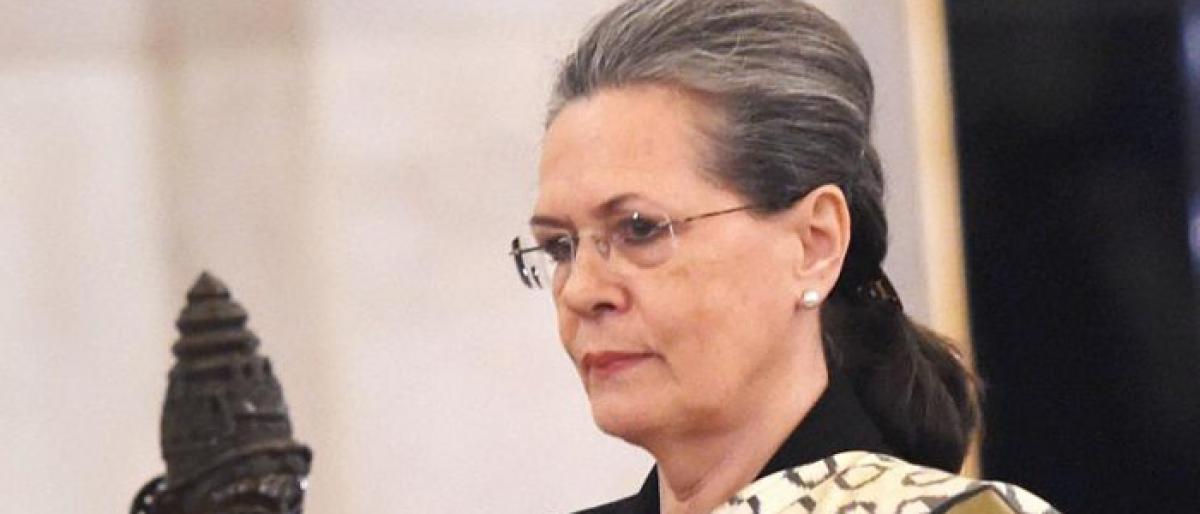Live
- Over 7,600 Syrians return from Turkiye in five days after Assad's downfall: minister
- Delhi BJP leaders stay overnight in 1,194 slum clusters
- Keerthy Suresh and Anthony Thattil Tie the Knot in a Christian Ceremony
- AAP, BJP making false promises to slum dwellers for votes: Delhi Congress
- 'Vere Level Office' Review: A Refreshing Take on Corporate Life with Humor and Heart
- Libya's oil company declares force majeure at key refinery following clashes
- Illegal Rohingyas: BJP seeks Assembly session to implement NRC in Delhi
- Philippines orders full evacuation amid possible volcanic re-eruption
- Government Prioritizes Welfare of the Poor, says Dola Sri Bala Veeranjaneyaswamy
- Two Russian oil tankers with 29 on board damaged due to bad weather
Just In

An indication as to how difficult it is going to be for the opposition at the national level to get its act together was available after K Chandrashekar Rao met Mamata Banerjee in Kolkata to lay the foundation for a federal front.
An indication as to how difficult it is going to be for the opposition at the national level to get its act together was available after K Chandrashekar Rao met Mamata Banerjee in Kolkata to lay the foundation for a federal front.
However, even before the proposed alliance could get off the ground, the differences about its framework were visible. While Rao wanted it to be a non-BJP, non-Congress group, his West Bengal counterpart kept her options open about including the Congress.
A feature of these alliances is that each of their constituents is guided by the ground realities in their own states which may be at variance with the political condition in some other state. For instance, the Congress may be a more formidable adversary for Chandrashekhar Rao in his state, but it isn't so for Mamata Banerjee. So, while the Telangana Chief Minister wants to keep the 133-year-old Grand Old Party at arm's length, Mamata Banerjee, a former Congress person, is more accommodative.
Similar conflicting perceptions are known even within one party such as the Communist Party of India-Marxist (CPI-M) where the Kerala comrades are against any proximity to the Congress, obviously because the latter is a force to reckon with in the southern state, but the Marxists in West Bengal are keen on a tie-up with the Congress against the BJP since they no longer face any major threat from their old opponent in the state. Rahul Gandhi's hope, therefore, of forming a "workable" anti-BJP alliance with other parties faces considerable roadblocks.
Yet, the BJP's current vulnerability is obvious to its political enemies. At the same time, the non-BJP parties know that none of them is capable on its own of offering a serious challenge to the ruling party at the Centre. Banding them together is the only alternative. The egos of individual leaders are also a problem, for none of them will be willing to concede the role of a leader to another.
Who can be the unchallenged leader in the non-BJP camp at present? Although the leaders in a federal front are highly influential in their home provinces, none of them measures up to the popular image of a Prime Minister who is a sober, sophisticated, well-educated, widely respected, trustworthy and unbiased person with a clearly identifiable vision.
To start with Sharad Pawar, who is among those who have shown an interest in leading the charge against the BJP, there has been a question mark over his reliability ever since his party was seemingly regarded by the BJP as a prop against the Shiv Sena's machinations in Maharashtra. He is generally seen as too clever by half and too much of a deal-maker to be trusted as the guiding light for the nation.
His age – Pawar is 78 – is also against him. India appears to be coming around to accepting Modi's view, as articulated by senior BJP leader Yashwant Sinha, that a politician is "brain dead" after 75. Rahul Gandhi at 48 is safe in this regard as is Mamata Banerjee (63). But while the Congress president is still considered not "grown-up" enough, the West Bengal Chief Minister is too immersed in her own province to be seen as a national leader.
Akhilesh Yadav (45) and Mayawati (62) have the same disadvantage of being rooted in the Hindi belt with its concomitant of casteism. Though also from the same region, 67-year-old Nitish Kumar was once considered a possible Prime Minister "material" before he shot himself in the foot with his politics of perambulation, forever looking for green pastures.
The bare cupboard of PM hopefuls leaves only 72-year-old Sonia Gandhi, who has been engaged in dinner diplomacy to cobble together an anti-BJP formation, as a possible candidate. But her minus points are obvious.
For one, she does not appear to be in the pink of health. For another, any whiff about her aspirations will make the Hindu Right revive the "foreigner" debate.
Yet, the former Congress president is possibly the only one with a much wider acceptability in the non-BJP camp than anyone else and also among the Dalits, backward castes and minorities as well as a section of the traditional Congress supporters in the upper caste though not among the middle class. In a way, she offers the best of a bad bargain with the resultant turmoil proving to be one of the worst in recent years.
By: Amulya Ganguli

© 2024 Hyderabad Media House Limited/The Hans India. All rights reserved. Powered by hocalwire.com







